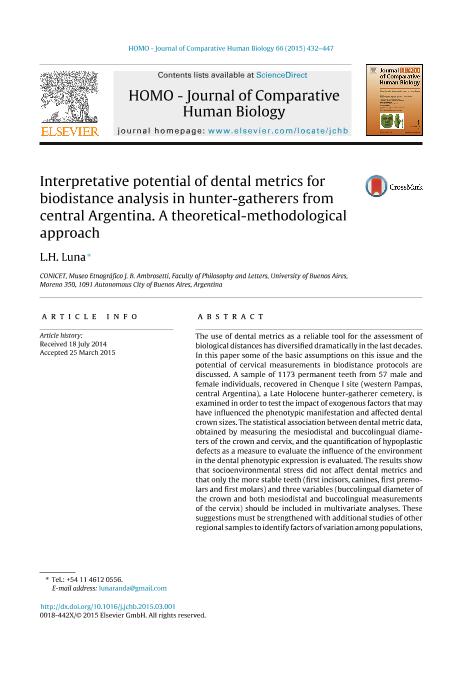Mostrar el registro sencillo del ítem
dc.contributor.author
Luna, Leandro Hernan

dc.date.available
2018-08-09T15:16:25Z
dc.date.issued
2015-10
dc.identifier.citation
Luna, Leandro Hernan; Interpretative potential of dental metrics for biodistance analysis in hunter-gatherers from central Argentina. A theoretical-methodological approach; Elsevier Gmbh; Homo : internationale Zeitschrift für die vergleichende Forschung am Menschen; 66; 5; 10-2015; 432-447
dc.identifier.issn
0018-442X
dc.identifier.uri
http://hdl.handle.net/11336/54770
dc.description.abstract
The use of dental metrics as a reliable tool for the assessment of biological distances has diversified dramatically in the last decades. In this paper some of the basic assumptions on this issue and the potential of cervical measurements in biodistance protocols are discussed. A sample of 1173 permanent teeth from 57 male and female individuals, recovered in Chenque I site (western Pampas, central Argentina), a Late Holocene hunter-gatherer cemetery, is examined in order to test the impact of exogenous factors that may have influenced the phenotypic manifestation and affected dental crown sizes. The statistical association between dental metric data, obtained by measuring the mesiodistal and buccolingual diameters of the crown and cervix, and the quantification of hypoplastic defects as a measure to evaluate the influence of the environment in the dental phenotypic expression is evaluated. The results show that socioenvironmental stress did not affect dental metrics and that only the more stable teeth (first incisors, canines, first premolars and first molars) and three variables (buccolingual diameter of the crown and both mesiodistal and buccolingual measurements of the cervix) should be included in multivariate analyses. These suggestions must be strengthened with additional studies of other regional samples to identify factors of variation among populations, so as to develop general guidelines for dental survey and biodistance analysis, but they are a first step for discussing assumptions usually used and maximizing the available information for low-density hunter-gatherer societies.
dc.format
application/pdf
dc.language.iso
eng
dc.publisher
Elsevier Gmbh

dc.rights
info:eu-repo/semantics/openAccess
dc.rights.uri
https://creativecommons.org/licenses/by-nc-sa/2.5/ar/
dc.subject
Bioarchaeology
dc.subject
Biological Distances
dc.subject
Dental Anthropology
dc.subject
Socioambiental Stressors
dc.subject.classification
Historia

dc.subject.classification
Historia y Arqueología

dc.subject.classification
HUMANIDADES

dc.title
Interpretative potential of dental metrics for biodistance analysis in hunter-gatherers from central Argentina. A theoretical-methodological approach
dc.type
info:eu-repo/semantics/article
dc.type
info:ar-repo/semantics/artículo
dc.type
info:eu-repo/semantics/publishedVersion
dc.date.updated
2018-08-08T14:01:38Z
dc.journal.volume
66
dc.journal.number
5
dc.journal.pagination
432-447
dc.journal.pais
Alemania
dc.journal.ciudad
Stuttgart
dc.description.fil
Fil: Luna, Leandro Hernan. Consejo Nacional de Investigaciones Científicas y Técnicas; Argentina. Universidad de Buenos Aires. Facultad de Filosofía y Letras. Museo Etnográfico "Juan B. Ambrosetti"; Argentina
dc.journal.title
Homo : internationale Zeitschrift für die vergleichende Forschung am Menschen
dc.relation.alternativeid
info:eu-repo/semantics/altIdentifier/doi/https://dx.doi.org/10.1016/j.jchb.2015.03.001
dc.relation.alternativeid
info:eu-repo/semantics/altIdentifier/url/https://www.sciencedirect.com/science/article/pii/S0018442X15000566
Archivos asociados
